
The Ultimate Guide to Conducting Interviews: Boost Your Hiring Success Rate
As a hiring manager, you know the weight of responsibility that comes with each interview. You're not just filling a position; you're shaping the future of your team and company. But let's be honest - conducting compelling interviews is more complicated than it looks. You've probably felt that sinking feeling when a seemingly perfect candidate turns out to be a poor fit or worse, when top talent slips through your fingers because your interview process didn't showcase your company's true potential.
The consequences of ineffective interviews can be devastating. You might find yourself dealing with high turnover rates, watching productivity plummet as mismatched hires struggle to keep up, or facing the frustration of restarting the hiring process all over again. The pressure to make the right decision can be overwhelming, especially when you know a single bad hire can disrupt team dynamics and set projects back by months.
But here's the good news: it doesn't have to be this way. Imagine the relief of confidently extending offers to candidates you know will thrive in your organisation and the satisfaction of watching your new hires seamlessly integrate and contribute to your team's success.
In this guide, we'll walk you through proven strategies to elevate your interview game. These strategies will help you identify top talent, reduce hiring mistakes, and create an interview experience that assesses candidates accurately and sells your company as an employer of choice. Let's get into it!
Why are compelling interviews important?
In today's competitive job market, identifying the right talent is critical for any organisation's success. The job interview is a pivotal point in recruitment, allowing a company to predict a candidate's future performance.
However, interviews are only as effective as how and when they are conducted. When they occur at the right place in the process (further down, after initial screenings) and are performed consistently and structured, interviews can give a company the confidence to move forward with its selection decision.
Methods to prepare for an interview
Preparing for an interview isn't just a box to tick - it's the foundation for wise hiring decisions that can shape your company's future. As an employer, preparing thoroughly allows you to identify top talent, showcase your company culture, and ensure a fair and efficient process. This preparation begins with a crucial first step: deciding what you are looking for in a candidate.
Decide what you are looking for in a candidate:
Before conducting interviews, it is crucial to establish a clear vision of your ideal candidate. This profile serves as a roadmap for your recruitment process, guiding you from creating the job description to the final selection. When developing an idea candidate profile, consider the following process:
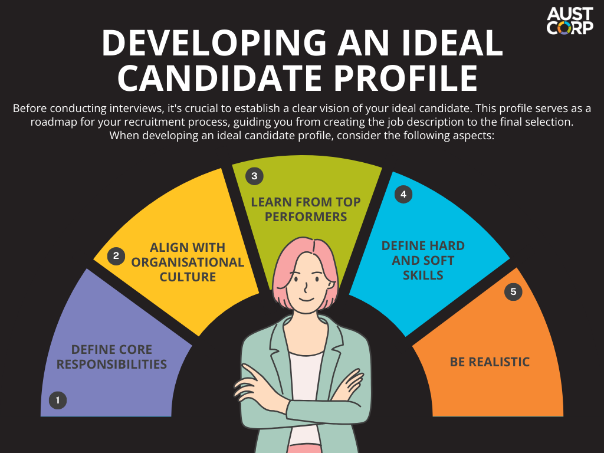
Define Core Responsibilities
Begin by outlining the role's day-to-day tasks and long-term objectives. Consult with team members in similar positions or their managers to gain insights into the critical requirements for success. Additionally, researching comparable roles in competitor companies can provide valuable perspectives on industry standards and expectations.
Align with Organisational Culture
Look beyond technical qualifications and consider how the ideal candidate fits your company's culture and vision. Reflect on the following questions:
Based on your company culture, what type of person would be successful in the role you are hiring for?
What personality traits complement your organisational values?
How can the right candidate contribute to achieving company goals?
What characteristics define successful employees in your current team?
Learn from top performers:
Analyse the attributes of your most successful employees. Identify common traits, skills, and behaviours that contribute to their excellence. This will help you define what you expect from your candidates and determine some of the commonalities, particularly when it comes to personality and soft skills.
Define Hard and Soft Skills:
Hard Skills are considered teachable abilities like experience with certain software or in a specific industry.
What is clear is that for any role, you will have a large set of relevant hard skills. However, you must refine this list into something usable for a candidate profile, job ads, interviews, and the entire hiring process.
To do this, you will need to divide these skills into separate sections, which include
What you need and can't train
What you need but can train
What you want
What isn't necessary
Anything that cannot be trained and is a skill you need to complete the job should go on the "must-have" list. This is often the most crucial element and the bulk of the candidate profile.
Finally, review the "must have" hard skills and remove any that are unnecessary and can be "nice to have" attributes.
On the other hand, soft skills are the personal characteristics that help individuals to be more successful at work. For example, leadership, communication, and problem-solving are all considered soft skills.
Once again, like hard skills, you must have a list of soft skills that will influence hiring decisions. Whilst they may be essential and relevant to the role, being able to assess them is not easy—and much harder to train if a candidate lacks them.
Because they are harder to identify and train, aim to be selective about "must-have" soft skills.
Be realistic:
Ensure you and your hiring team know that it is unlikely to find a candidate that matches the candidate profile exactly. Remember you are looking for someone who embodies the profile's spirit and matches most of the line items, not necessarily every single one.
Learn more about the candidate.
Effective interviewing begins long before the candidate walks through the door. A comprehensive review of the applicant's background is crucial for conducting a productive and insightful interview.
Pre-Interview Research
Dedicate time to examine all available information about the candidate thoroughly. This includes:
Carefully studying their resume and cover letter
Reviewing their professional online presence, such as LinkedIn profiles
Analysing any portfolio or work samples provided
By familiarising yourself with the candidate's background, you avoid asking redundant questions, saving valuable interview time.
Identify Areas for Clarification
As you review the candidate's information, make a note of:
Unusual job titles that may need explanation
Gaps in employment history
Frequent job changes or career shifts
Specific achievements or projects that warrant further discussion
These points can serve as springboards for more in-depth conversations during the interview.
Leverage Additional Resources
In some cases, you may have the opportunity to gather more information before the interview:
Contact-provided references (if appropriate at this stage).
Research the candidate's previous employers to understand their work environments.
Check any publicly available professional work or contributions.
Collaborative Interviewing: Striking the Right Balance
Incorporating multiple perspectives in the interview process can significantly enhance your hiring decisions. However, it's crucial to maintain a focused and efficient approach.
Optimal Interview Panel Size
While seeking input from others is valuable, limiting the number of interviewers is essential. A panel of two to three people is generally considered ideal for several reasons:
It provides diverse viewpoints without overwhelming the candidate
It allows for a more dynamic and conversational interview style
It ensures that each interviewer has ample opportunity to ask questions and assess the candidate
Selecting the Right Interviewers
Choose your interview panel members carefully, considering:
Their expertise relevant to the role
Their ability to assess different aspects of the candidate's fit
Their understanding of the company culture and values
Assessing Cultural Fit
To gauge how well a candidate might integrate into your team:
Consider inviting potential future colleagues to participate in a portion of the interview process
Arrange informal meet-and-greets with team members, if appropriate for your organisation
Coordinating the Interview Process
To maximise the effectiveness of a multi-interviewer approach:
Assign specific areas of focus to each interviewer to avoid redundancy
Brief all interviewers on the candidate's background and the role requirements
Schedule a post-interview debrief to share observations and reach a consensus
By thoughtfully involving others in the interview process, you can gain valuable insights while maintaining a structured and candidate-friendly experience. This balanced approach helps ensure a comprehensive evaluation of technical skills and cultural fit, leading to more informed hiring decisions.
Prepare the candidate for success.
Creating a positive interview experience is a proactive process that begins well before the actual meeting. By taking the initiative to address candidates' concerns and providing them with essential information, you can empower yourself to set the stage for a more productive and insightful conversation.
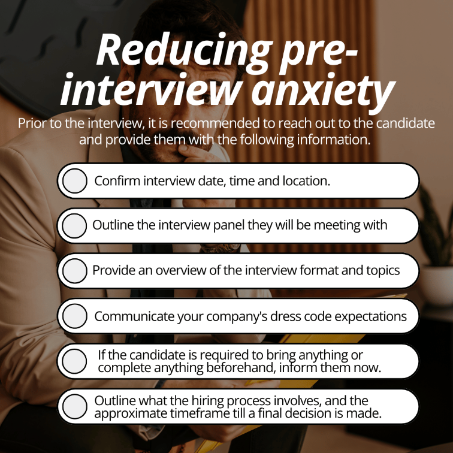
Create a comfortable interviewing atmosphere.
Choosing your space for the interview is essential. Consider how small or large the room is, how many windows it has, the amount of privacy it offers and the amount of outside noise present.
Decide on an interview format.
We all like to think we're unbiased when it comes to hiring. But when you break it down, many hiring decisions are based on criteria that differ from how well the candidate will do in the role.
Studies show that 39% of interviews are rejectedbased on the candidate's confidence level, tone, or smile. You might not even realise you are being biased, but if you are short of committing to blind hiring, how can you solve this issue?
Changing the way you interview can help.
What are unstructured interviews?

Unstructured interviews are pretty much what they say. You let the interview unfold like a conversation, and though you might have general topics you want to cover, you don't have a specific set of questions written down.
Unstructured interviews offer flexibility and a conversational approach. While they can reveal unexpected insights about candidates, they come with significant drawbacks:
Lack of consistency across candidates
Increased potential for unconscious bias
Difficulty in making objective comparisons
Risk of discussing legally sensitive topics.
What are structured interviews:
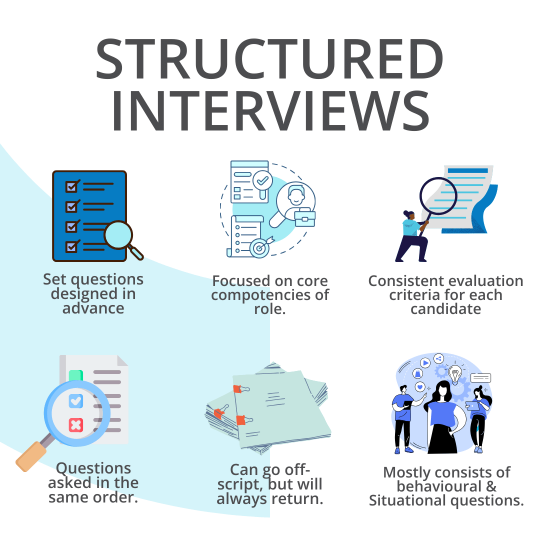
Most people are familiar with the structured interview—a formal atmosphere, prepared questions, and lots of discussion about the skill requirement for the job and how the candidate plans to meet your company's needs and expectations.
They involve:
Predetermined questions asked in a specific order
Consistent evaluation criteria for each candidate
Reduced influence of personal bias
Better legal compliance and defensibility of hiring decisions.
To implement structured interviews effectively:
Develop a comprehensive set of questions based on your candidate profile
Create a standardised rating scale for evaluating responses
Train interviewers to follow the structured format consistently
Document responses objectively during the interview
A structured interview process levels the playing field so you can evaluate each candidate on the same traits, increasing the odds that you will pick the closest match to your ideal candidate profile. A thoroughly planned interview will also help you keep on track, focusing on the details you need to know to decide.
A fully structured interview is your best protection for reducing bias and ensuring an objective hiring decision. However, it doesn't have to be an all-or-nothing decision. You can use an overall structured approach – predesigned questions, order and ranking scale – and incorporate un-prepared questions. You might allow some free-form conversation at the beginning or end of the interview or allow yourself one or two follow-up questions that aren't entirely on task.
Combat your bias
Interviewing bias refers to the preconceived ideas that can influence the evaluation of candidates during job interviews. An interviewer's perception of these candidates may be conscious, meaning they are aware of their thought process, or unconscious, meaning they are unaware of them. This bias can result in
Poor hiring decisions
Increased employee turnover
Reduced workforce diversity
Hindered inclusivity effort
Ways to avoid interviewer bias in your selection process
Use standardised questions: For each job, have a set of questions you ask each candidate in the same order. This way, you don't veer into similar-to-me bias or inconsistency in questioning.
Take notes as you go: Instead of waiting until the candidate leaves to write down your impressions (which can tend towards similar-to-me bias, stereotyping, and halo/horn bias), write down your impressions as you go. Preparing a standardised sheet with room for answers can keep things accurate and is critical to ensuring a structured process.
Grade candidates on a rubric: Before you begin the interview process, determine which skills are essential and look at those skills individually. This will help you avoid stereotyping, first impression bias, contrast effect, etc.
Require anonymous test assignments: These should be short and non-actual work that benefits the business. Every candidate should receive the same assignment – whether writing a piece of code, analysing a data set, etc., and judging the work product without identifying candidates. This will help eliminate all biases if the work is directly related to the job's needs.
Have multiple people interview the candidate: Each interviewer should have questions about their expertise and job requirements. The candidate may feel they are answering the same questions with different interviewers, but the idea is to get a clear picture while reducing bias.
Don't use your gut: Sometimes, you may like a candidate or feel that this person is best. Using the above methods to evaluate candidates will give you a quantifiable answer for the best candidate. Your gut will often use your own biases disguised as intuition.
Develop a list of purposeful questions.
Before you meet candidates face-to-face, you need to determine precisely what you are looking for in a new hire so that you can ask the right questions during the interview.

Behavioural Questions:
Behavioural questions aim to uncover how candidates have handled real-world situations in the past. They can show you how the candidate approaches specific duties or challenges so you can predict how they are likely to act in scenarios relevant to the position. Some behavioural questions you can ask include:
Can you give me an example of an ambitious goal you achieved thanks to a new or innovative approach you used?
Tell me about a time when you made a significant mistake that impacted your team. How did you handle it?
Have you had to manage several important projects under tight time constraints in the past? If so, how did you organise your work?
Share an example of how you were able to motivate a coworker and help them improve their performance.
Tell me about a time when you had to use your negotiation skills to get everyone on the same page. How did you approach the situation, and what results did you achieve?
When evaluating responses, look for concrete examples, the candidate's thought process, and lessons learned from the experience. Click hereto view other examples of behavioural questions to ask candidates.
Situational Questions:
Situational questions present hypothetical scenarios to candidates, challenging them to describe how they would handle specific work-related situations, with the purpose of assessing their problem-solving abilities, decision-making abilities, and potential job performance in real-time, even if they lack direct experience in certain areas. Some example's of situational questions include:
You realise your manager has made a big mistake on a substantial project. What would you do?
What would you do if a team member wasn't pulling their weight on a group project?
Image a key client who is dissatisfied with our product. How would you approach resolving their concerns?
Please pay attention to the candidate's reasoning and the practicality of their proposed solutions. Click here to view more examples of situational questions you can ask.
Skill Based Questions:
Skill-based questions uncover whether an individual's skillset matches the organisation's requirements. These questions require candidates to discuss their existing skills and those they want to develop.
When developing your skill-based questions, refer to your candidate profile, specifically the skill section. This will ensure that your questions align with the role's specific requirements.
Prioritise key skills: When crafting these questions, focus primarily on the "must-have skills", especially critical hard and soft skills that cannot be trained on the job.
Hard Skill Questions:
Can you walk me through your experience with (Specific software or tool)
How would you approach (specific task relevant to the role)?
What is one professional or technical skill you would like to develop?
What tools do you typically need to diagnose problems in your field?
How would you allocate business funds appropriately?
Soft Skill questions:
Communication: Describe when you had to explain a complex concept to someone without a background.
Adaptability: Tell me about a situation in which you had to adjust quickly to a significant change in your work environment.
Leadership: Can you share an example of how you motivated a team to achieve a challenging goal?
Problem-solving: Describe a creative solution you developed to address a recurring issue in your previous role.
Teamwork: How do you typically handle disagreements within a team?
Skill Development Potential:
While focusing on existing skills, also explore a candidate's capacity for growth.
What is a skill you have recently acquired or improved? How did you approach learning it?
In what areas do you need further development to excel in this role?
Click hereto view more examples of skill-based questions you can ask during the interview.
Cultural/Value Fit Questions:
Beyond questions that help determine whether a candidate fits the role, it is essential to consider company culture.
According to a 2021 PwC survey, 66% of C-Suite executives think culture is more critical than organisational performance. In fact, 71% of leadership respondents report that their culture helps make change initiatives happen.
However, we know that interviewing for cultural fit needs to be updated. So, how do you find the right questions to ask in an interview about culture?
Hiring for cultural add VS cultural fit:
First, let's understand the difference between hiring for cultural fit versus cultural add:
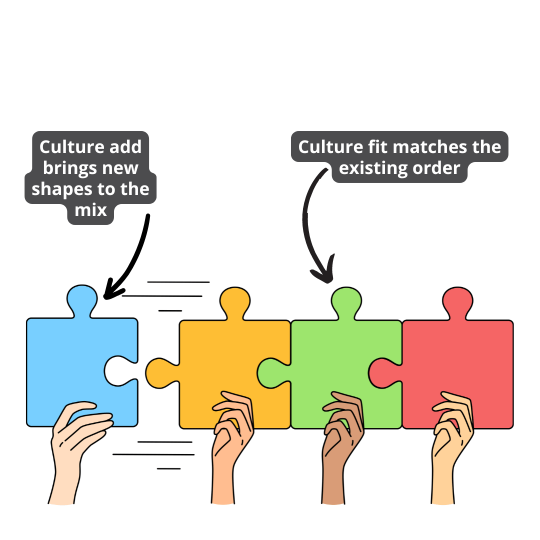
Cultural Fit: We define cultural fit as sharing the same behaviours, values, interests, and work preferences. But the key part of this phrase is the term "Fit"." To fit into a culture, a person must have some sort of homophily. In short, cultural fit is about looking for someone based on their similarities to the group.
Cultural Add: A cultural add is someone who brings diverse experiences, perspectives, and ideas to a workplace. This perspective embodies the idea that a culture enhances and adds to the current company culture. A culture shares certain core behaviours and values necessary to the group but shows and interprets them differently. A cultural add empowers growth for the team and individuals.
Hiring for cultural fit could mean encouraging bias (Especially unconscious bias). Similarly-minded and homogenous groups can encourage groupthink, which can spiral into toxicity or even hostility in the workplace.
However, hiring for cultural ads encourages diversity, which is better for your employees and business. Diverse teams and teams with diverse perspectives and approaches have more energy and potential for productive friction. They work more intelligently and are better equipped to solve complex problems.
Culture-Add Interview Question Examples:
In what ways do your colleagues benefit from working with you as opposed to one of your coworkers?
Tell me about a time when understanding someone else's perspective helped you accomplish a goal or resolve a conflict.
From your perspective, how can we improve our culture or values? What values would you bring to our organisation?
How do you measure success at work? How does a successful day at work look for you?
Tell us about a time you received feedback from a manager or colleague. How did you react? What lessons did you learn?
How do you like to be managed? What characteristics do you look for in a leader?
Based on your knowledge of the role, do you have any recommendations or ideas for improving?
How do you typically approach working through a challenging problem? What's your approach to teamwork and collaboration?
What fundamental values or behaviours are most important to you in a company?
What attracts you to the company values? How do our core values align with your personal value system?
Click here to view more examples of culture-add questions you can ask during the interview.
Motivation-based questions:
These questions seek to uncover the drive and motivation behind an applicant's application. This can reveal a candidate's reasons for applying and whether their values align with the organisation's.
What are your biggest aspirations in life – work or otherwise?
Please walk me through your career from when you left high school. Why did you study what you did or take the path you did?
What do you enjoy most/least about your current role?
What aspects of this position do you find most appealing?
Describe your ideal work environment. What factors contribute to your productivity and job satisfaction?
Look for genuine enthusiasm and values that align with your company's mission and culture.
Click here to view more examples of culture-add questions you can ask during the interview.
How to structure an interview:
Introduce yourself
The introduction sets the tone for the entire interview, making it a crucial step. A well-executed introduction can put the candidate at ease and create a positive first impression of your company.
Begin by greeting the candidate warmly as they enter the room. Offer a firm handshake or an appropriate professional greeting based on your company culture and current health guidelines. Make eye contact and smile to create a welcoming atmosphere.
Next, clearly state your name, professional title, and role in the interview process. For example: "Hello, I'm Sarah Johnson, the Marketing Director at XYZ Company. I'll be conducting your interview today."This clarity helps the candidate understand who they're speaking with and establishes your authority.
During the initial stages of the interview, it is a good idea to note their body language, tone, and level of confidence.
Have a quick chat
After introductions, a brief, informal conversation can help create a more comfortable atmosphere that encourages open communication throughout the interview.
Instead of resorting to cliche topics like the weather or traffic, aim for more meaningful conversation starters. This is a great time to bring up common ground topics. When researching your candidate you may find common interests or experiences related to your or the company. This might include the same university, company or hobbies. This practice will help you establish a connection and show empathy towards your candidate.
Review the job
Before delving into detailed questions, it's crucial to provide an overview of the position. This step ensures that both you and the candidate are aligned on the role's expectations and requirements, setting the stage for a productive interview.
Briefly outline the key responsibilities, team structure, and how the position contributes to the company's goals. For example, "As our Marketing Coordinator, you'll manage our social media presence, create blog content, and assist with email campaigns. You'll work closely with our design team and report to the Marketing Manager."
This review serves multiple purposes: it refreshes the candidate's memory about the role, allows them to ask any initial clarifying questions, and helps you gauge their genuine interest and understanding of the position. Please pay attention to their reactions and follow-up questions, as these can provide insights into their enthusiasm and preparedness for the role.
Set expectations for the interview
After reviewing the job details, it is recommended that you set some clear expectations for the interview to help put the candidate at ease and allow them to prepare mentally for what's to come.
Some things to consider converting when setting the expectations include:
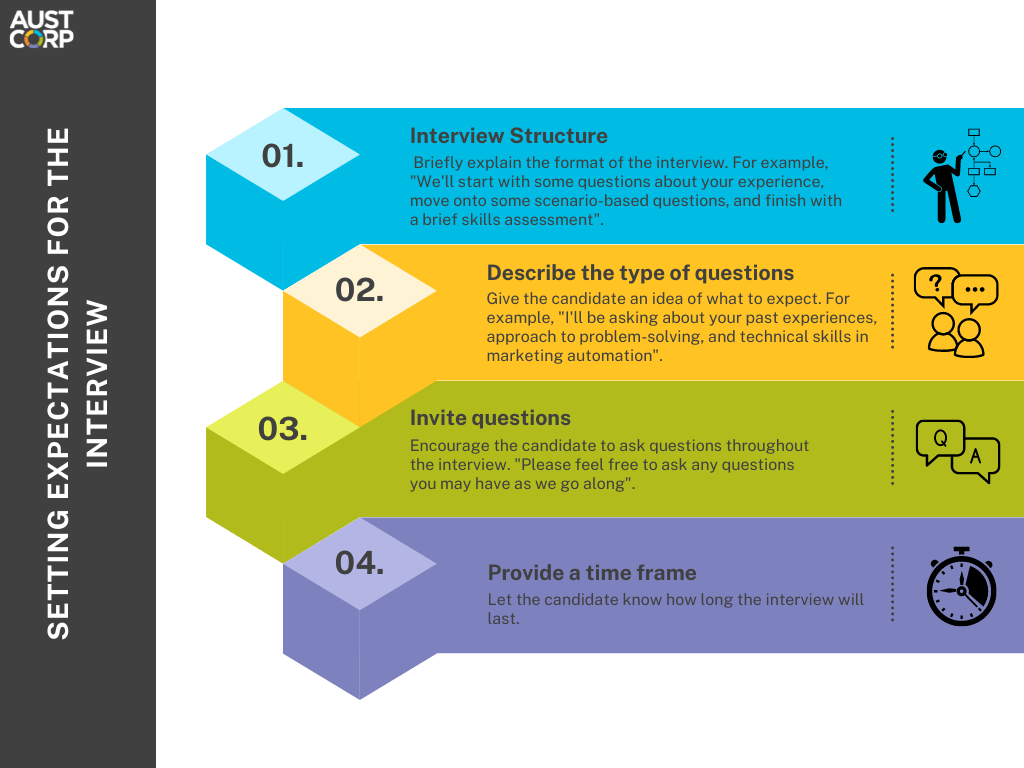
Asking your Interview Questions
When conducting the interview, structure your questions to build a comprehensive understanding of the candidate progressively. Begin with background and experience questions to establish rapport and context.
Then, move on to behavioural questions, asking for specific examples of past performance to predict future behaviour. Follow these with situational questions to assess problem-solving skills in hypothetical scenarios.
Next, delve into skill-based questions, both hard and soft, to evaluate the candidate's technical abilities and interpersonal competencies. Incorporate cultural questions to understand how the candidate might enhance your company's culture and bring diverse perspectives.
Include motivation-based questions to gauge the candidate's career aspirations and alignment with your organization's goals. Finally, ask questions about work style preferences and how they handle stress or pressure.
Throughout the interview, remain flexible and ask follow-up questions based on the candidate's responses to gain deeper insights. This structured approach ensures a thorough evaluation of the candidate's qualifications, potential, and fit for both the role and your company culture.
Sell the job
During an interview, many hiring managers assume that candidates need to sell themselves to the employer. They don't consider that it's just as crucial for the employer to sell the company, position, and culture to the candidate.
If the candidate is as great as you think they are, you can guarantee you're not the first person to contact them that week about an "amazing opportunity." There is a lot of competition, so you must be smart about selling the job and the company.
Finding out what the candidate wants:
As any good salesperson will agree - the first step towards a successful sale is to start by asking questions. Ask the candidate what they're looking for in their next role. Aside from salary expectations, you should also be able to gather what priorities are essential for the candidate and sell against those specific priorities. Tailor the perks of the role and company to suit the candidate's particular requirements, and you will have a much higher chance of convincing them that it's the right fit for them. In the process, learn about any reservations they have and, if they are a highly desired candidate, work with them to find a solution that would make the job more appealing.
Selling the company to the candidate:
Being that roughly 70% of candidates are passive job seekers, they aren't going to leave their current companies if they don't seek any tangible reasons to accept a new position. You'll need to demonstrate to candidates exactly why you'd be a great employer to work for:

Selling the position to the candidate:
When meeting with prospective employees, you want to share what you need and highlight the benefits of the position in terms of personal satisfaction, professional growth, and working alongside others who feel the same way about their jobs.
Explain why they're perfect for the role: Just telling the candidate that they're perfect for the role isn't going to convince them - you need to explain why you think they're suitable for the role and back it up with details you've learned about their particular skillset or experience. That way, they'll see you've done your research and that you care about finding them a job they love. When listing out a few of the primary skills required for the role, bring each point back to why the candidate's background suits each thing you mention. For example, "Steve, the line manager, is looking for someone with extensive payroll experience, and with five years of this under your belt, I know he'd be interested in meeting you". If you give the candidate this level of detail and demonstrate how suitable they are for a role, you'll build their confidence that they are a good fit, and they will be more likely to buy into the opportunity.
Discuss the benefits of the position: During the interview, share with your candidate any exciting projects or opportunities for growth. Essentially, give them an overview of what their daily routine (and beyond) could look like and how this could align with their own personal and professional goals.
Discuss the role expectations: Some employers initially get it right but then get caught up in their own needs. When discussing what the job entails and what your expectations are, step back from yourself. Instead, frame your messaging around the candidate's experience to help them view themselves in the position. This will give them food for thought and help them envision how they can contribute.
Remember, the objective isn't to persuade someone to accept a position they're unsuited for but rather to educate candidates about the opportunity and enable them to make an informed decision. By focusing on alignment between the candidates' aspirations and what your company can offer, you're more likely to make a successful hire that benefits both parties in the long term.
Discuss the following steps and end the interview.
Ending the interview professionally and transparently is crucial for maintaining a positive candidate experience and setting clear expectations. Here's how to effectively wrap up the interview:
Outline the following steps:
Clearly explain the subsequent stages in the hiring process.
If applicable, mention the possibility of a second interview and potential timeframes.
Inform the candidate about any additional assessments or tasks they might need to complete.

Provide a timeline: Give the candidate a realistic timeframe for when they can expect to hear back from you. Be specific, for example, "We aim to decide by next Friday."
Address any remaining questions: Offer the candidate an opportunity to ask any final questions they may have about the role or the company.
Collect additional information: If needed, ask for any remaining documents, references, or portfolio samples.
Express appreciation: Thank the candidate for their time and interest in the position.
Offer your contact information: Provide your email or phone number in case the candidate has any follow-up questions.
End positively: Maintain a professional and encouraging tone regardless of your initial impressions.
Remember, how you conclude the interview can significantly impact the candidate's perception of your organization. A study by CareerBuilder found that 68% of candidates believe their experience during the hiring process reflects how the company treats its employees. Therefore, ensuring a positive end to the interview can enhance your employer's brand and increase the likelihood of securing top talent.
Transform Your Hiring Process: Partner with AustCorp Executive
Are you struggling with your interviews, facing consistent turnover, or finding it challenging to attract the right talent? Don't let these hurdles hold your company back. At AustCorp Executive, we understand the complexities of the hiring process and the impact it has on your organization's success.
Take the first step towards transforming your hiring strategy. Contact us today for a confidential conversation with one of our senior consultants who can assist you in refining your interview process and enhancing your overall hiring journey.
Why partner with AustCorp Executive?
Expertise in Executive Search: With over 27 years of experience, we specialise in connecting top talent with leading organisations across the APAC region.
Tailored Recruitment Solutions: Our approach is customised to your specific industry, company culture, and role requirements, ensuring a perfect fit every time.
Comprehensive Candidate Assessment: We go beyond resumes, utilising advanced screening techniques to evaluate candidates' skills, cultural fit, and long-term potential.
Ongoing Support and Guidance: Our partnership extends beyond placement, offering continued assistance to ensure successful onboarding and retention.
Don't let hiring challenges hinder your company's growth. Reach out to AustCorp Executive today and take the first step towards building the high-performing team your organization deserves.
Read More Hiring Tips and Guides
Hungry for more Hiring advice? Check out these relevant blogs to further enhance your hiring journey.
